10 Top Tips for Home Security
We've put together our 10 top tips for home security to give homeowners peace of mind and to help deter burglars
Last updated - 02/12/2022
Estimated reading time - 10 minutes
Lock your doors and windows
The first of our 10 top tips for home security is a simple but often neglected one - lock your front and back doors. 70% of burglars gain access to a property through a door, and in over 50% of domestic burglaries, someone was at home, so even if you are at home or only popping out for a few minutes, make sure you shut and double lock your front and back door.
In terms of windows, always shut and lock them when you leave your home. When you are at home and you want your windows open for ventilation, make sure you take appropriate steps to ensure thieves cannot gain access to your home through an open window. We’ll show you how in the next part of our 10 top tips for home security.
Secure your doors and windows
Your home is only as secure as its weakest point of entry, so it is important to make sure that your doors and windows are as secure as possible.
If you live in a house, check that your front and back doors are fitted with BS3621 locks, or BS8621 if you live in a flat or apartment. BS3621 and BS8621 locks have been tested against common burglary techniques, such as lock picking and drilling, by the British Standards Institute and are therefore tamper-resistant and durable. Some home insurance policies require that front and back door locks meet these standards. If your home insurance policy states this and your locks do not meet the standard, your claim may not be valid if your home is burgled.

Ensure your front and back door locks have the British Standard Institute Kitemark and the British Standard number BS3621, or if you live in a flat or apartment, BS8621, engraved on the lock, if not, get them replaced as soon as possible.
All sliding doors and windows should be fitted with anti-lift devices to prevent them from being removed from their tracks. Anti-lift devices reduce the gap between the frame and the top of the door or window, meaning that the door or window cannot be lifted off the runners.
For added security on uPVC doors or windows, install sash jammers. If a thief manages to bypass the door or window lock, sash jammers will prevent it from opening.

If you have sash windows, you can also install sash stops. Sash stops allow you to lock open your sash windows for ventilation while also preventing your window from being opened wide enough for someone to climb through.
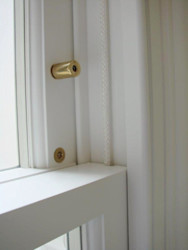
Sash stops and jammers can be purchased for as little as £5 each.
If you have French doors, check that the door handles are SS301 Bronze or TS007 2* approved and the lock cylinder is SS312 Diamond or at least 3* Kitemark approved. For added security to your French or patio doors, you can use a patlock. A patlock holds the internal door handles in place, so if a burglar manages to break the lock from the outside, the external handles will be held firmly in place and prevent them from opening the doors.
Patlocks are easily fitted and can be released in seconds without the need for keys or a code. You can buy a patlock for around £50.
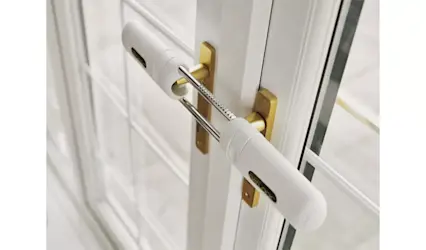
Although taking extra steps to secure your windows can prevent an intruder from opening them to gain access to your property, an intruder might attempt to smash them to bypass any locks. Installing laminated glass to easily accessible windows can prevent this. Laminated glass is made of two layers of glass with a vinyl layer in between. When smashed, laminated glass doesn’t shatter, as the vinyl layer in between the two panes of glass holds the glass together and creates a barrier that is difficult to break through.
Replacing your windows with laminated glass can be quite expensive. Security film is a cheaper alternative that provides a similar level of protection as laminated glass, but instead of replacing your existing windows, you only need to apply the security film to them.
Install a home security alarm system
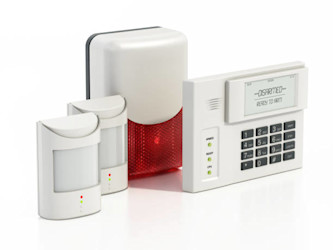
One of the best ways to feel secure in your home is to install a home alarm system. An alarm system will give you peace of mind knowing that your home is better protected when you are at home or away. Your home is less likely to be broken into if you have a visible alarm, as it can deter potential intruders and make them think twice about breaking into your property. If they do break into your home, the alarm will be triggered and will set off a loud siren to scare off the intruder, and if you have a smart alarm system, it will notify you on your smartphone.
If you would like the police to be automatically contacted if your alarm goes off, you will need to pay a monthly fee to have your alarm system actively monitored by a professional home security company. When your security system detects a break-in, fire, or any other emergency, it will alert the alarm company, who will then call you and the appropriate emergency services if need be.
Not only will installing an alarm system add more security to your home, it could also reduce your home insurance premiums, as many insurers offer lower premiums for households with security alarms.
Make sure you remember to set your alarm whenever you leave your home and before you go to sleep. If you often forget to set your alarm, leave a note on your front door or set up a reminder on your phone until setting your alarm becomes a habit.
Install security and surveillance cameras
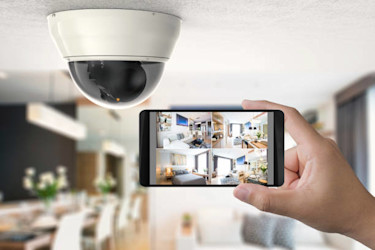
Installing visible security cameras around the perimeter of your home acts as a deterrent to potential intruders and also provides evidence should they break in.
Alternatively, you can have a video doorbell installed. A video doorbell will notify you via your smartphone when someone rings your doorbell or if it detects motion. As well as receiving activity alerts, you will be able to talk with visitors using the two-way audio function, and stream live footage directly to your smartphone.
As well as installing outdoor cameras or a video doorbell on the outside of your property, you should also install surveillance cameras inside, so you will be able to keep an eye on what’s happening inside your home.
Installing security and surveillance cameras as part of your home alarm monitoring system will provide your monitoring company with live footage of your home once an alarm has been triggered, and they will be able to take appropriate action.
Light up your home
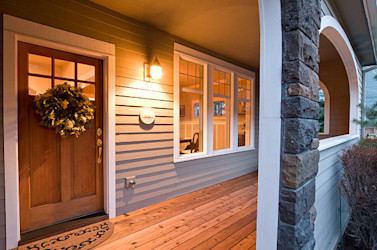
Burglars prefer to operate under the cover of darkness, so make sure the area outside your home is well lit. Consider installing dusk to dawn lights that stay on throughout the night or motion sensor lighting that shines brightly once it detects motion to the front and back of your home.
Burglars also tend to approach homes that look unoccupied, so even if you aren’t at home, make your home look like you are. To do this, you can install light timers. Light timers are a convenient way to control your home’s lighting when you are not at home. Simply plug the timer into a plug socket, then plug your lamp into the timer. When you leave your home, set the timer to the times you want the light to turn on and off.
If you would prefer to control or schedule your lighting from your mobile phone, you can install smart bulbs or connect your lamps to a smart plug.
Don’t make it obvious that you aren’t at home
If your home is going to be unoccupied for a long period of time, take steps to avoid making it apparent that you are not at home.
Postpone any milk, newspaper, or other deliveries so they don’t pile up outside your door and alert people that you are not at home. If you don’t manage to cancel deliveries, have someone you trust go to your home to collect any post or deliveries that accumulate.
If you are away on holiday and you want to post on social media, make sure your posts are private and that they can only be seen by trusted family and friends, as holiday pics can alert people to the fact that you are away and your home might be unattended.
If you have smart lighting, schedule it to turn on at sunset and dark mornings to give the appearance that someone is at home.
Keep valuables and keys out of sight
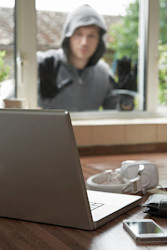
Most burglars are opportunists, so leaving your valuables in clear sight could tempt one to break into your home. Keep gadgets, jewellery, and any other valuables that might attract a thief out of sight. Lock them away in a cupboard or, better yet, a safe.
When purchasing a safe, look out for independent stamps of approval such as the AIS or Sold Secure logo, as they mean that the safe is insurance approved. All security safes have an insurance rating that indicates their level of security and the maximum amount of cash that you can keep in the safe and be covered by your insurer in the event of a burglary. The higher the insurance rating and the security level of the safe, the harder it will be for a burglar to break into it.
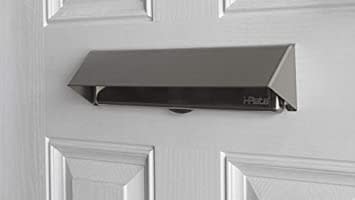
You should also avoid keeping any small valuable possessions, such as your handbags and keys, near the front door as some burglars are known to use a “fishing” technique to pull them through the letterbox. Letterbox fishing involves thieves looking through a letterbox to see what possessions have been left near the front door. If they see any items within reach that are small enough to get through the letterbox, they then thread a long, hooked rod through the letterbox to retrieve them. If the thief manages to fish out your keys, they could then let themselves into your home or drive off with your car without any signs of forced entry. To prevent this, you should get a letterbox guard. A letterbox guard prevents a thief from seeing into your home through your letterbox and also prevents them from using tools to reach into your home to grab nearby keys or valuables.
Secure your garage and shed
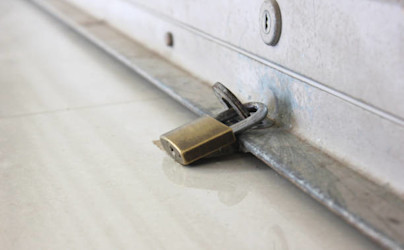
If a burglar can’t get into your home, they might try to break into your garage or shed instead. Your garage or shed might have valuable tools or items left in storage that a thief would love to get their hands on. Your garage may even have tools and objects, such as a crowbar or a ladder, that an intruder could use to break into your home.
Pay attention to the type of screws used in the hinges on shed doors, as standard screws can easily be removed. Replace standard screws with clutch head screws. A clutch head screw is a one-way screw, which means that once you have screwed it in, it cannot be unscrewed. If your shed or garage has windows, cover them up so thieves can’t see what is inside, and install security film to prevent a thief from breaking them and entering your shed or garage.
Lock valuable tools and objects with padlocks and chains, or inside a locker. For larger items like bikes, ladders, lawn mowers, etc., secure them to a lockable stand or to a ground anchor.
When locking up your home, don’t forget to lock and secure your garage and shed.
Safely store spare keys
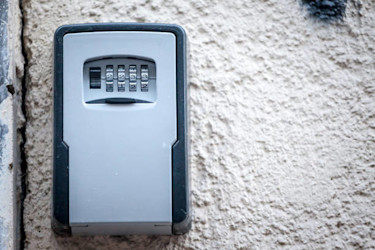
Most burglars are well aware that some people hide spare keys under doormats, in plant pots, in an unlocked shed, etc.
If you often need to leave a spare key, leave it with a trustworthy friend or family member or with a trusted neighbour. If you don’t have anyone nearby that you can leave your spare keys with, then consider getting a wall-mounted key safe. Wall-mounted key safes have a reinforced body that can withstand sawing and hammering and are locked and unlocked with a code.
When buying a key safe, ensure that it has been approved by the Loss Prevention Certification Board (LPCB) and has a Police Preferred Specification. The LPCB is a world-leading certification body that sets the standards needed to make sure that fire and security products and services perform effectively.
A Police Preferred Specification is given to security products that have met or exceeded rigorous security standards, meaning they are able to withstand physical attacks by casual and opportunistic criminals.
Remember, a key safe is only secure if it has been fitted correctly. When fitting a key safe, follow the manufacturer’s instructions and ensure that it is fitted securely to a solid concrete or brick wall in a discreet location using the fittings provided.
The two most secure key safes currently on the market are the Supra C500 and the Supra P500, which can be bought for around £55 and £80, respectively.
For a full list of security products that are LPCB approved, click here.
Check your home security often
The last part of our 10 top tips for home security is to make sure you check that all the security measures are operating as they should.
Make sure all your security equipment is working and up to date. Check that your security and surveillance cameras are recording clear footage and that dust or objects aren’t obscuring their view.
You should also test that your alarm system is working correctly every month. You can do this by putting your burglar alarm in test mode. Once in test mode, set your alarm as normal and trigger it by opening a door, or if it is motion activated, walk around your home to activate the sensor. If the alarm does not go off, then your alarm system isn’t working, and you will need to get it sorted out immediately. Don’t forget to change your alarm codes a few times a year and only give them to trusted people who need access to your home. If you have a key safe, change its code at the same time you change your alarm code, but do not use the same code for both.
Conduct a security review by walking around your home and garden and thinking about how you would break in. If there are any security lapses, deal with them right away.

